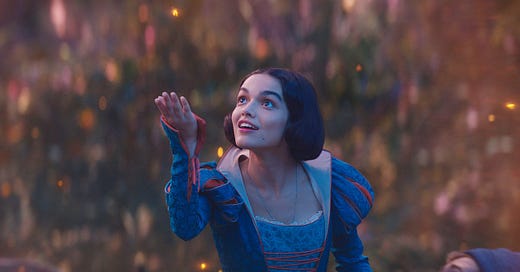'Snow White' Review
Disney's latest cash grab remake once again fails to justify its existence
*spoilers ahead*
Where to begin? It feels as though the discourse and controversies surrounding Disney’s Snow White have been circling the internet for so long, and yet now that it’s finally been released the finished product is just another bland retelling of a classic fairy tale from a postmodern perspective that is devoid of any wonder or magic. And yet I’m left to wonder who could have expected anything different.
From the release of Maleficent back in 2014 to their remake of The Little Mermaid in 2023, Disney has made a steady stream of live-action remakes of their beloved animated classics. These productions usually feature big name stars in the lead roles, copious amounts of garish CGI, and more than a few edits to the source material in order to update them for “modern audiences.” At their best they can be a refreshing update that still remains faithful to the source material, such as 2015’s Cinderella. However, most of them are just derivative of the original animated films, trying to recreate as many scenes as possible in live action while adding in a few unnecessary subplots to pad out the runtime.
Snow White, however, is somewhat different in this respect. The film opens with the narration telling us that the king and queen of the land were caught in the middle of a snowstorm when they had their child and so named her Snow White, as a reminder of the trial that they had to overcome. This is followed by our first musical number, wherein the residents of the kingdom sing about the perfect utopian kingdom that they live in, where everyone shares with all and nothing bad ever happens. This is the first of many new songs that were written for this film and the choreography, lyrics, and set design that were being presented during this scene felt like one of those midday shows that you might catch at Disney World while you take a break in between Splash Mountain and The Haunted Mansion.
What follows thereafter is the section of the movie that most resembles the 1937 film. The notable exception during this first half is the exclusion of the prince. Instead, we are introduced to the leader of a group of bandits (more on them later) named Jonathan (or as I call him, “discount Flynn Ryder”) who is caught stealing from the castle and is then freed by Snow White. Eventually, Snow White finds herself in the cottage of the Seven Dwarfs, who in this version are fully CGI characters.
It became clear while watching this movie that these CGI additions were not the original intention for this movie. Let me explain. While this movie was still being filmed, a now-infamous set photo was released of seven people, only one of whom was an actor with dwarfism. There was much outcry and backlash to Disney seemingly doing away with the dwarfs of “Snow White and the Seven Dwarfs,” so Disney decided to pivot, choosing to use full CGI characters so that the only person they had to get back on set for reshoots was Rachel Zegler. But what makes the scenes of the dwarfs stand out so much is the fact that the seven characters from the infamous photo are still in this movie. They serve as discount Flynn Ryder’s troupe of bandits, but there isn’t enough runtime for us to learn anything about any of them, even though they make an attempt for one of them.
In addition to the Dwarfs feeling like a rushed add on, there is also the Evil Queen played by Gal Gadot. It’s a performance that has been getting a lot of negative feedback, and I can’t say that I disagree. The presentation of the character fell pretty flat, simply because she never felt evil
despite that being her primary descriptor. There is no sort of menace from the character and she never feels like a scary villain. They even give her a new villain song, which is in my opinion the worst scene in the movie but also the best scene, because I couldn’t stop laughing at how ridiculous it was.
With all of the side characters covered, I should now talk about Snow White herself. More internet backlash occurred when Rachel Zegler, the actress who plays Snow White, made some comments in an interview about how the original Disney film was outdated and we modern audiences should be beyond such things as a princess needing to be saved by a prince. However, that is pretty much what happens in this film. She does still eat a poisoned apple and gets woken up by a supposed true love’s kiss, but it’s no longer the end of the movie, which unfortunately undercuts any significance that such a moment should have in this story.
In his famous essay “On Fairy Stories” J. R. R. Tolkien coined the term eucatastrophe, which can be defined as “the sudden turn of events in a story which ensures the protagonist does not meet a terrible, impending or probable doom.” Tolkien’s prime example of eucatastrophe within our own lives was the Incarnation and the Resurrection of Christ. Examples of this within literature would of course be the ending of The Lord of the Rings, but also more significantly to this review, the ending of Snow White and the Seven Dwarfs, wherein an act of love has the power to overcome death itself. In the 2025 remake, the wicked queen taunts Snow White as she is dying, revealing to the princess that her father is dead. So upon being awoken by a kiss from discount Flynn Ryder, there is little time for celebration as suddenly Snow White is saddened once again since she is reminded that her father is truly dead. Not exactly the romantic fairy tale moment that one might expect. But this then sets the stage for the third act where Snow White marches back to the kingdom and defeats the queen by showing that she is a better fit to lead the people. Then the queen in her anger smashes her magic mirror, which turns her into glass shards for some reason, and she’s sucked into the mirror, so it all kind of works itself out.
It's become clear that the folks at Disney are not at all interested in the films they are making. There is no moral message to be found here. Every decision that was originally made for this film was for the sake of political correctness, but when there was suddenly so much backlash to everything they were doing, they backtracked on it. Thus, the finished product resulted in a movie that, in trying to satisfy everyone, satisfies no one. And so, once all of the discourse and outrage online dies down in a few weeks, it will join the ranks of all the other Disney live action remakes and will hopefully become a forgotten thing of the past. I would like to think that Disney can finally learn their lesson from this, seeing that the box office returns for this were not pretty. But if the live-action Lilo and Stitch remake coming out this summer ends up being a hit, then I wouldn’t bet on it.







Like most of these Disney remakes, I'm more interested in seeing the animated version again. I haven't read the original source material, but I have seen the forgotten live-action horror version of the story from 1997 called Snow White: A Tale of Terror. I saw it once on cable when I was in the 8th grade and I really liked it then, but I'm not so sure I would now. Based on what you wrote about this new film, it reminded me of some similar elements:
First, she is born in the snow, but under much more ghastly circumstances.
Second, we see her father the king (Sam Neill), but he actually survives in this one.
Third, her love interest isn't a prince but part of a motley crew of "rough" characters, but I don't think they're bandits. There's one little person in it, just like that group that got scrubbed from the new movie.
Fourth, she is awoken at the end of the second act (not the end) by her love interest, but here he shakes her until she coughs out the piece of apple.
Lastly, the final sequence has her going back to the castle to defeat the evil queen (Sigourney Weaver) and she does it by stabbing the mirror, which oozes blood and magically causes the queen to have a fatal stab wound. This made sense to me though because throughout the movie, whenever the queen speaks to the mirror, she sees a misty image of her own face.
Speaking of the queen's death, does anyone else think that she is implicitly killed by God in the 1937 animated film? I mean, she's struck by lightning (kind of), falls off a cliff, gets smashed by the boulder she was going to use against the dwarves, and then gets eaten by vultures. I hope I'm not being sadistic (God forgive me if I am), but that's one of my favorite villain death scenes.
I wasn't planning on seeing Snow White, but your review makes it definite! Thanks for mentioning the live-action Cinderella which had a few weak moments, but overall was very well done. I particularly like the scene at the end where she forgives her stepmother, a good lesson for children.